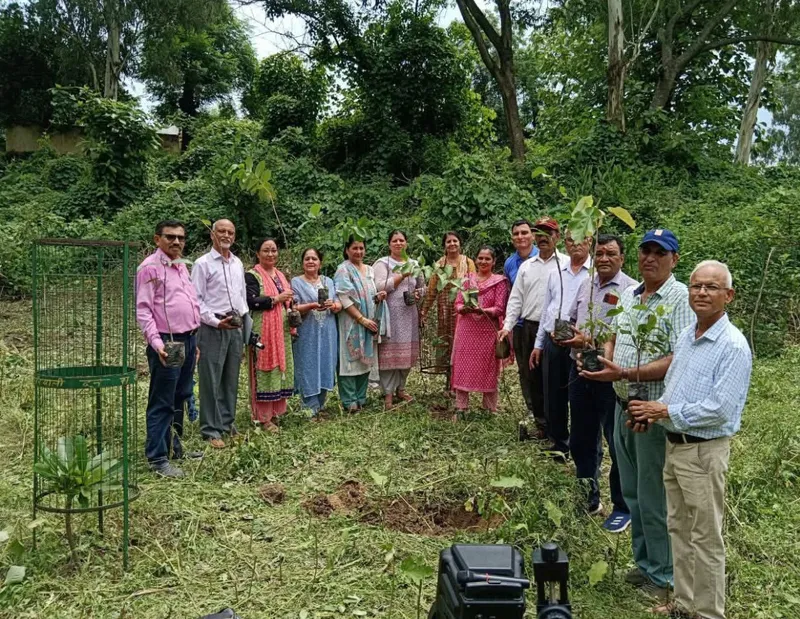A forest in Dehradun in memory of lost friends and family
Smriti Van is a memorial forest in Ashhal village of Dehradun created with the efforts of NGO Dhad. It has around 400 trees planted by locals and visitors, in memory of a dear one they lost.
In Asthal village of Dehradun, a mango tree stands as a living tribute to JK Singh’s parents. A businessman and a resident of Dehradun for 14 years, Singh remembers his late mother for her deep fondness for mangoes.
At Smriti Van where he and his wife planted the mango sapling three years ago, there are over 400 trees, each dedicated to a loved one who has passed.

A tree planting session
Smriti Van is one of the forests created by the local NGO Dhad in Dehradun, Uttarkhand, which has taken a unique approach to afforestation in the region, completely relying on public support.
Forests like Smriti Van aim to transform ecological restoration from an abstract environmental responsibility into a deeply personal and emotional act. By intertwining the act of afforestation with love and remembrance, it invites even those who might not otherwise engage with environmental causes to take part in restoring nature.
“Grief and memory are universal experiences. The idea of planting a tree in honour of a loved one creates a tangible, living tribute—one that not only keeps their memory alive but also contributes to a greener, healthier ecosystem,” says Tanmay Mamgai, Secretary of Dhad.
“Our approach was, and always will be, creating sensitised citizens. While as an NGO, we always have the choice to get funding from the government, go on a plantation drive, and show big impact numbers, we have time and again chosen to involve the public in our campaigns, even if it means creating awareness with patience and enduring delays in completion of projects,” he adds.
Reverence for nature
Mamgai and his team at Dhad have been working to restore Uttarakhand’s local culture and its deep connection with natural resources for over a decade. In this region, people have looked at nature as not just a resource; it is sacred, says Mamgai.
“All festivals, including Holi and Diwali for us have been harvest festivals. Families have traditionally welcomed the onset of monsoon by planting a tree at their house, year after year. As times changed and the intimate relationship of the communities with nature withered, we simply set out to remind them of these roots.”
Across the Himalayas, especially in Uttarakhand, reverence for the natural world is deeply woven into religious and cultural traditions. Forests, rivers, and mountains are seen as manifestations of divine energy, and festivals and celebrations often centre around honouring and preserving them.
One such celebration is Harela, a festival that marks the onset of the monsoon. Families sow seeds in small baskets of soil and watch them sprout as a symbol of fertility, prosperity, and harmony with nature. On the festival day, saplings are planted in fields, forests, and public spaces, reinforcing the community’s commitment to afforestation.
Similarly, Van Mahotsav has special significance in mountain regions where tree-planting is seen as both a spiritual duty and a means of protecting fragile ecosystems. Many villages also have sacred groves—patches of untouched forest protected as abodes of deities, where cutting trees is strictly prohibited.
How Smriti Van came about
It was during the Halerla festival that Dhad began engaging with the locals on environmental sensitivity and plantation drives. The team travelled to homes, schools, colleges and village communities, planting saplings with the locals and worshipping the onset and departure of seasons.
“We went to the government with a proposal: to do a plantation drive for a whole month on one patch of land in Uttarakhand. They allotted us a piece of land on the banks of a small seasonal river.
“It was filled with pebbles. We took it upon ourselves to plough the land, till and resoil it to make it fertile again. We started planting saplings dedicated to people who have contributed to the culture and history of Uttarakhand: Jeet Singh Ne Gee, Hira Singh Rana, Omkar Das, Chandra Singh Garhwali, Sridev Suman and George Grierson, among others,” Mamgai describes how Smriti Van came about.
When the pandemic came, Mamgai and his team started a campaign asking people to dedicate a sapling to their loved ones, and pay Rs 100 every month for a year for its upkeep and to pay the guard taking care of the forest.
“We would urge them to plant local varieties that grew well— Jacaranda, bottle crush and Amaltas, which are beautiful, vibrant flowering trees. Sometimes, they would dedicate fruit bearing or other flowering trees that had a connection to their loved ones, and we encouraged that.”
Geethanjali M, a young resident of Uttarakhand, dedicated a few such flowering trees for her aunt.
“I couldn’t find a better way of remembering her,” she says.
Haven for biodiversity and healing
While Smriti Van is a memorial forest, Bal Van, a plantation drive inside a school, was carried out by children. Jeev Van and Mitr Van have been planted entirely by the team of Dhad and the general public of Uttarakhand.
In total, these manmade forests account for about 700 trees today.
Set against the lush backdrop of Dehradun’s green belt, these forests have become a haven for biodiversity, attracting birds, butterflies, and other wildlife. More than just a grove of trees, they embody the collective efforts of families, environmentalists, and the local community.
“This emotional connection makes ecological restoration more accessible and meaningful, moving it beyond statistics and policies into the realm of personal legacy and healing,” says Mamgai.
Edited by Swetha Kannan






